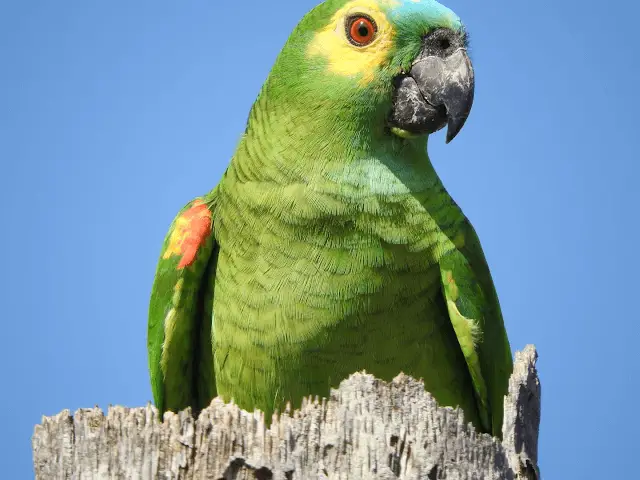
- Weight:280 – 510 g,Length:33 – 38 cm
- Conservation status: Least Concern (Decrease)
- Rank: Species
- Top Classification: Amazon
- Class: Birds
- Order: Psittaciformes
- Famille: Psittacidae
CITES Appendix II, freeholding not subject to quotas
No sexual dimorphism
Phenotype:
- blue fronted amazon parrot phenotype with a pronounced yellow on the face, a blue mask, and red “epaulets”. The color pattern is very variable from one individual to another
- Existing but rare phenotypic mutations
Character: blue fronted amazon parrot able to speak (a few words and great impersonator of noise) even if it is quite destructive. Amazons are reputed to be very stubborn and should not be recommended to a beginner
Blue Fronted Amazon Weight: 350 – 400g
Distribution:

Order: Psittaciformes
Family: Psittacidae
Kind: Amazona
blue fronted amazon size: Measures approximately 33 cm long.
Longevity: About 40 years old.
Blue fronted Amazon (Amazona aestiva aestiva)
Blue fronted Amazon (Amazona aestiva aestiva) Physical description
Stocky bird with green plumage with some yellow spots. The area around the eyes is yellow and the forehead is pale blue. The eyes are surrounded by light skin with dark irises circled in orange. It has a sturdy dark gray spout. Its legs are dark.
The Amazon with a blue front in Paraguay is identical with the only difference that the yellow-red of the shoulders and the blue of the face are more marked.
Known as comics and feathered swaggers, they are entertaining bird who really enjoys spending time with their human flock. That’s why they make great pets. You will also find them very good at speaking. It is a large parrot. So you will need a lot of space and time to lead a happy and healthy life.
Turquoise-fronted Amazon Parrot
The Swedish botanist, Carl Linnaeus, was the first to record the blue fronted Amazon parrot in the zoological archives in 1758. The species has a very wide distribution. There are wild populations in Buenos Aires.
We know that at least one wild population is found near Stuttgart, in Germany. This is likely due to the fact that the pet parrots escaped and formed a flock that grew over time.
The blue fronted Amazon generally inhabits the woods and forests. They live in large herds and tend to form a strong bond with their partner. Like most parrots, they nest in tree cavities where the female takes care of most of the incubation and care of the young.
Although it is difficult to know how many Blue fronted Amazonians live in the wild, they are considered to be endangered. Their ICUN red list status classifies them as “Least Concern”.
Despite an apparent reduction in numbers, this not yet vulnerable status is justified by the fact that their distribution is so vast that dangers such as loss of habitat and hunting for the pet trade risk not affect them much. However, it is also noted that this is likely to change in the future.
Blue fronted amazon lifespan
Well-maintained, the blue fronted Amazon can live up to 80 years of age. Most will be at least 40 years old, although a few live almost 100 years.
Blue fronted amazon temperament
Active and funny, the blue fronted Amazons are natural artists. They love being around their owners and will harass them for more attention. When socialized well, these parrots will enjoy the company of the whole family, although they tend to choose their favorite.
Although generally non-aggressive and good with other birds, some people are known to protect their guardians when they perceive danger. The bombing of the assailant was common behavior at the time. In addition, males may become slightly territorial during breeding or molting.
Prolific speakers and singers, they often vocalize and can be very loud when they want to be. Although the blue fronted Amazons speak well, they will cry even better. You can expect one-morning awakening and another at sunset to postpone their natural instincts, although they usually only last 10 minutes. For people who live nearby, such as apartment buildings, these birds can be a little too noisy and disturb your neighbors.
SOURCE:Bling Bling the BSS of the ISS
Blue fronted Amazon parrots Colors and markings
The primary color of this parrot is beautiful lime green. Their common name comes from a patch of blue or turquoise just above the beak. Although this is the mark of like
Their common name comes from a patch of blue or turquoise just above the beak. Although it is the trademark of the species, the breeding has created a wide range of marks on the heads of birds. This makes it easier to distinguish an individual parrot from the group.
Some birds do not have a blue head while others have an almost entirely turquoise head. Yellow usually surrounds blue and stretches above and below the head before giving way to the bright green feathers of the body. You might even find birds with white spots.
Generally, the blue forehead has splashes of bright red on the shoulders and flight feathers, which can also have a purple hue in flight. It also varies from individual to individual and some have only green shoulders, especially the wild parrots found in northwest Argentina.
In captivity, there are a few color mutations, such as the cinnamon blue fronted Amazons, which have yellowish feathers rather than green. The lutino variant usually has white feathers where you would normally expect yellow. There is also a blue mutation that produced an entirely blue bird with yellow spots.
As a rule, the beaks are black and the feet gray. It’s a monomorphic species, so males and females are alike. The only way to know the sex of your bird is through DNA sexing or surgery.
Blue fronted Amazon Care
blue fronted amazon for adoption: These birds are very intelligent and social and they need regular human interaction. Don’t adopt an Amazon parrot if you don’t have a lot of time to spend with it.
In fact, the more active your parrot is in the house, the happier it will be. Whether you watch TV, clean up, or have dinner, blue faces will want to be part of the action. A portable game stand that you can move from room to room can become your home and it will reward you with acrobatic antics wherever you are.
The minimum recommended cage size for an active bird such as a Blue-fronted Amazon is a 3-foot cube, although larger is better. If you can’t get a very large cage, try to compensate for it by allowing extra time out of the cage each day.
While you can usually find them in pet stores, it’s best to go through a bird breeder. They will be able to verify the origins of your new animal and its health, which is important for any exotic bird. Contact the local bird breeders and ask if you can visit them and spend time with their birds. Seeing a blue-fronted Amazon parrot in its native environment will give you a good idea of what it means to live with such a parrot. The more you can visit him before you bring him home, the better.
Blue fronted amazon diet
blue fronted amazon diet: A healthy diet should include high-quality pellets, a mixture of quality seeds, and daily servings of fresh, bird-safe fruits and vegetables. In essence, many people who are considered healthy can feed these parrots in moderation, and owners say they particularly like chicken. Avoid avocados and chocolate as they are toxic to birds.

blue fronted amazon diet
All Amazons are active parrots, and blue-fronted people should have a minimum of three to four hours a day outside the cage, especially if their cage is small. It allows him to play and stretch his wings and be part of the family.
These birds love to climb and chew, so it is recommended that Amazon parrot owners provide their pets with many toys, including ladders and ropes. Keep a few extra chew toys ready to replace those that get too worn out and your bird will not run out of toys to keep you entertained in your absence.
Bath time is a special joy for the blue fronted amazon parrot Provide a bowl of water just for that and it will get comfortable. Some birds like to be sprayed with water while others may request a bath in the sink. Follow your bird’s thread and use it as another occasi
blue fronted amazon price

Blue fronted Amazon parrot is often more expensive: their price varies from breeder to breeder and the price range is between 1,000$ to 1,200$.




















